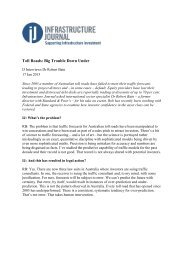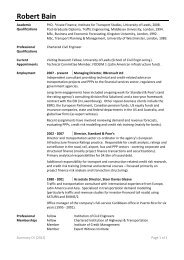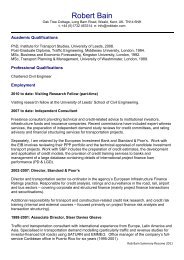Disincentivising overbidding for toll road concessions
Disincentivising overbidding for toll road concessions
Disincentivising overbidding for toll road concessions
- No tags were found...
Create successful ePaper yourself
Turn your PDF publications into a flip-book with our unique Google optimized e-Paper software.
DISINCENTIVISING OVERBIDDING FOR TOLL ROAD CONCESSIONS<br />
Box 2.2 UK value-<strong>for</strong>-money assessment guidance<br />
The VfM framework in the UK is based on ensuring that:<br />
••<br />
risks are allocated to the party that is best placed to manage and minimise these risks over the contractual<br />
period;<br />
••<br />
focus is placed on the whole-life costs of the asset;<br />
••<br />
an outputs specification approach is used to describe the project requirements;<br />
••<br />
there is a rigorously executed transfer of risks to the parties that are responsible <strong>for</strong> them;<br />
••<br />
there is sufficient flexibility to ensure that changes can be accommodated during the life of the project at<br />
reasonable cost;<br />
••<br />
potential rewards and deductions are included to create sufficient incentives <strong>for</strong> efficiency and timely<br />
delivery within the procurement and project delivery processes;<br />
••<br />
due consideration is given to the terms of the contract, including its duration, given the life of the assets and<br />
the accuracy of cost <strong>for</strong>ecasting;<br />
••<br />
there are sufficient skills and expertise in both the public and private sectors, and these are utilised during<br />
the project;<br />
••<br />
the scale and complexity of the procurement process are manageable.<br />
Source: HM Treasury (2006), ‘Value <strong>for</strong> Money Assessment Guidance’, November, p. 8.<br />
The UK Department <strong>for</strong> Transport (DfT) applies this framework and has developed a criterion of its own to analyse the<br />
business case <strong>for</strong> certain projects. This requires that projects are categorised according to their benefit–cost ratios,<br />
adjusted <strong>for</strong> wider economic impacts. The categories are as follows.<br />
Table 2.2 VfM assessment<br />
VfM category<br />
Benefit–cost ratio<br />
Poor Less than 1.0<br />
Low Between 1.0 and 1.5<br />
Medium Between 1.5 and 2.0<br />
High Between 2.0 and 4.0<br />
Very high Greater than 4.0<br />
Source: HM Treasury (2006), ‘Value <strong>for</strong> Money Assessment Guidance’, November.<br />
DfT guidance published in December 2004 suggests that, with respect to the above considerations, the DfT should<br />
generally undertake:<br />
••<br />
no projects with poor VfM;<br />
••<br />
very few projects with low VfM;<br />
••<br />
some, but by no means all, projects with medium VfM;<br />
••<br />
most, if not all, projects with high VfM. 55<br />
While it will not in itself address the issue of <strong>for</strong>ecast bias, undertaking this analysis from an early stage should at<br />
least prevent schemes from going ahead that are never likely to provide good per<strong>for</strong>mance. This should prevent<br />
problems arising down the line where per<strong>for</strong>mance (i.e., traffic) is significantly lower than expected. Ensuring that<br />
projects are built on a strong economic and commercial case could there<strong>for</strong>e mitigate some of the <strong>overbidding</strong> issues<br />
which are discussed below. It can also save on costs, since cancellation becomes increasingly expensive as the<br />
project enters the design phase, and is even more unlikely once construction has begun.<br />
55 Department <strong>for</strong> Transport (2004), ‘Value <strong>for</strong> Money Guidance’, December.<br />
22






